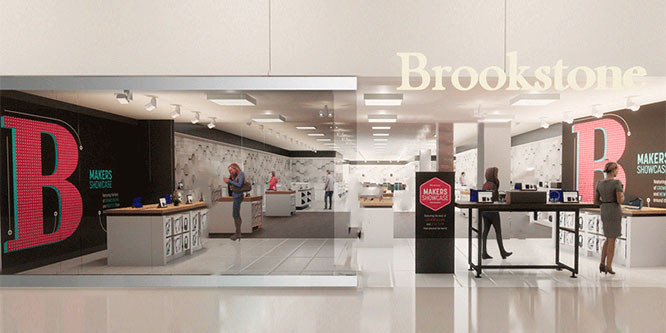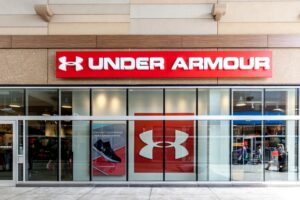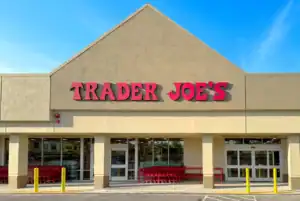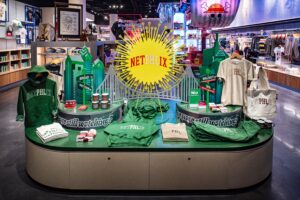
Image: Brookstone
August 3, 2018
Empty malls spelled the end for Brookstone stores
Back in 2014, when Chinese firms purchased Brookstone out of bankruptcy, the big question was whether they would be able to turn the gadget retailer’s fortunes around considering increasing competition online and lagging traffic at malls where the chain’s stores were located. The short answer to that question appears to be “no” as Brookstone has once again declared that it is heading into Chapter 11 and closing its 101 mall-based stores.
Brookstone blamed the bankruptcy and need to close stores on “continued deterioration of traditional mall traffic.” The retailer, which once operated 310 stores, plans to keep open 35 airport stores along with its e-commerce and wholesale businesses. The company is hoping to sell those.
Shuttering its stores will make Brookstone part of a trend with more and more retailers abandoning malls across the country. Last month, CNBC reported that vacancy rates at malls were at the highest level (8.6 percent) since the third quarter of 2012 (8.7 percent).
“The decision to close our mall stores was difficult, but ultimately provides an opportunity to maintain our well-respected brand and award-winning products while operating with a smaller physical footprint,” said Piau Phang Foo, Brookstone’s CEO, in a statement.
Brookstone announced it has secured around $30 million in financing to help it pay for vendors as it reorganizes under Chapter 11.
- Brookstone files for bankruptcy and will close all of its mall stores – CNN Money
- Brookstone files for bankruptcy protection again and will close remaining mall stores – The Associated Press/Los Angeles Times
- Brookstone files for bankruptcy protection and plans to shutter all 101 mall stores – CNBC
- US malls haven’t been this empty since 2012 – CNBC
- Can Brookstone’s new owners revive the gadget retailer? – Fortune
Discussion Questions
DISCUSSION QUESTIONS: Is Brookstone’s failure more a story about the plight of malls or simply a retailer who lost its relevancy? Are there other mall-based retail chains that you think are likely to follow Brookstone?
Poll
BrainTrust
Mohamed Amer, PhD
CEO & Strategic Board Advisor, Strategy Doctor
Recent Discussions







Brookstone’s conversion rates I suspect are the real problem, which points to relevance over interest. Malls may not be be the ideal store locations, over airports for example, so a pruning by Bookstore is overdue.
Retailers need to stop blaming “declining mall traffic” for the all their troubles. While it may be true that traffic in some malls is down, as a retail traffic analyst, I can tell you that it’s not down everywhere. The more important question is, what was Brookstone doing to convert the traffic it did get? Store traffic is vital — it ultimately defines the sales opportunities stores have but without a focus on conversion, traffic doesn’t do much good.
I agree that lack of mall traffic has to have impacted Brookstone. But the allure of shopping Brookstone for “cool” gadgets has been diminished by an economic reality — more than 50 percent of shoppers just don’t have the income to splurge on gadget “wants” versus household needs. Online and in airports, Brookstone should make a big push for holiday gifting!
Given the business in which Brookstone was supposed to be, that is, cool and useful gadgetry, it appears to be more about execution of a neat concept than about declining mall traffic. Yes, traffic has been down in malls but if it had the right product mix (read: unique and attractive), and the stores are exciting, Brookstone could do better. When a Warby Parker announces the expansion of its brick-and-mortar footprint through new mall locations, why shouldn’t Brookstone be able to thrive?
Sorry, I don’t think you can pin this on mall traffic. Stale product offerings pegged too much to massage chairs and air purifiers meant failure was fairly predictable. They were b8ta before b8ta. If you can answer the question, “what’s new?” for shoppers, they will seek you out. Anything less becomes, “I’ve seen that” and they move on, whether in an airport or a shopping mall. Blame their buyers for lackluster merch and their employee training for their appearing as jaded ambassadors in what should have been a fun store for adults.
Brookstone’s fate is a result of both their mall-based physical store retail strategy and their relevance in an Amazonian world. Brookstone stores were once a novelty destination to mall shoppers when there were actually notable numbers of mall shoppers. As mall traffic drops, so does Brookstone’s sales. According to reports, Brookstone will be keeping their airport locations. Airports seem to be the new shopping mall — or should I say, shopping terminal.
While declining mall traffic is certainly part of the problem facing Brookstone these past few years, I tend to look at stories like these as more of a “chicken or egg” question: Are mall stores failing because mall traffic is declining, or is mall traffic declining because mall stores failed to engage shoppers with updated models that brought them into the mall? Perhaps if Brookstone had reinvented their experience, maybe by adding maker’s workshops to their stores, for example, they could have attracted more traffic to their stores. Could they have contributed to the resurgence of the mall (which I believe is coming, they just won’t look like they have for the past 40 years)?
I totally agree, Dave … The allure of the Brookstone massage chair (that few could afford) is going to create conversion — in-store experiences could have gone a long way to help these guys.
The challenge for Brookstone is the narrow nature of their assortment and the limited purchase occasions. Two additional drivers operated in parallel: 1.) Growth of online retailing especially with mega-competitors like Amazon as well as smaller ones such as The Sharper Image; 2.) the fall of foot traffic in malls and their slow erosion as consumer destinations per se.
Retail profitability is sensitive to sales volume and is proportional to existing fixed cost. A 10 percent reduction in foot traffic can be calamitous to a specific store that depends on impulse and walk-by consumers. Inventory decisions and vendor relationships become even more important and any in-store cost-cutting can easily backfire. Without a strong and consistent source of consumer demand, the weaknesses in any business model will become magnified.
Similar to Toys “R” Us, Brookstone’s stores were filled with product, with most of them still in the packaging. There were little opportunities to engage with the product, and it certainly wasn’t an encouraged interaction in-store. Those products are just better tested in-store than acquiring online. Lost relevancy and purpose has a lot more to do with it than deteriorating mall traffic.
Given where I live (Miami), which seems to be on its way to becoming the mall capital of the world, it’s hard to have a solid perspective on “declines in mall traffic.” But I can’t dismiss other opinions, either.
What jumps out at me with regard to Brookstone is that they probably get more favorable rent deals from airports, which is frankly surprising, but seems like it must be true.
In general, though, I think Brookstone is a concept whose time has come and gone. Its kitschy products were well suited to Boomers when we were in our 30s. Now the product is either available elsewhere or has become a yawn.
I have to say that it still seems like an odd decision that likely speaks to the lower rents I mentioned above, and a captive audience of travelers waiting for planes.
I can’t imagine another chain that would make this kind of decision except maybe Sbarro.
Malls didn’t kill Brookstone — the Internet did. Brookstone succeeded in its early days because it was a reliable place to discover interesting new merchandise, but there are now hundreds of online sites where shoppers can find compelling new offerings, like www.itechdeals.com. The writing has been on the wall.
Blaming declines in mall traffic is like blaming the weather for poor sales. No one has ever given credit to great weather and strong mall traffic as reasons for retail success! Other concepts are expanding into malls (see Fabletics, Aerie, Warby Parker), so Brookstone’s demise is due to an outdated concept. The model of a store for gadgets was great before everyone walked around with a “gadget” (smartphone) at all times. Brookstone didn’t provide a reason to shop there — it wasn’t a highly curated assortment of cutting edge products and didn’t have highly-trained sales associates.
Maybe “it’s the economy, stupid … ” While the headlines and stock market all talk to a glowing outlook, the reality for the vast majority of people (who don’t own stocks and have no 401ks) is that they can’t afford to make impulse buys of products whose common thread is “a lot of stuff that nobody really needs.”
When a retailer sells a product that is more of a “want” than a “need” it will always be about having eyeballs in the store (or on a catalog or webpage). Selling “wants” is a very difficult and a daunting task — and requires the creation of exciting messages to build traffic on an item the customers have never considered and really don’t need. To be in a mall with extremely low traffic counts, trying to sell lots of impulse items without big audiences I think spells real trouble.
Brookstone’s real issue was converting shoppers into customers. Their conversation ratio was simply not high enough. The number of people who came through their doors was based on the hope of finding something unique and worth the price.
Two things happened. Yes, the decline in mall traffic may have lowered the amount of potential foot traffic, but the real issue was once customers were inside the store the items displayed were no longer seen as desirable and/or unique.
Bygone Brookstone is a symptom of a larger disease: Malls need to get away from 1980s thinking and start to get tenants that matter. Fitness centers, WeWorks, food halls, Bonobos, Warby Parker, Tesla. Just ask the developers of Easton in Columbus, they have them all and are anything but empty.
My brother was recently in from San Francisco and never goes to malls. I showed him one and he said, “it hasn’t changed in 30 years!” Exactly.
“Declining traffic … ” — Nonsense. It’s true but by no means a death knell. Brookstone had an opportunity to become a version of a “Genius Bar” for whole range of fun, clever products. My mantra is Explore + Experiment = Experience. By that definition, Brookstone was an experiential retailer a couple of decades ago. I suppose you could argue that Apple and Microsoft and the phone companies siphoned off what was left of the mall traffic. Maybe. But Brookstone could also have evolved. They didn’t.
This is very interesting because Brookstone is a brand that is all about experience. Even before experience became a mantra. Their failure lies more in their lack of playing to that end than in the decline of mall traffic. And that is my 2 cents.
Another sad story; another one bites the dust. I agree with several of my fellow contributors when it comes to blaming their failure on mall traffic. I think that may have been a contributor. But mall traffic is not the total answer. Somewhere along the way Brookstone lost its relevance with the shopper. Most of what they sold was in the impulse buying category. not that many people go to a mall looking to buy a higher-priced impulse item. Most go to get what they intended to buy and leave. Sure, there is some window shopping and playing with the Brookstone “toys.” But buying those toys is another thing. They are too expensive for too many of today’s shoppers.
I agree with many members of the BrainTrust — declining mall traffic hurt the brand, but don’t forget they did have freestanding stores and they even attempted to do an experiential merchandising play by adding in new inventions from small brands. I think retailers like b8ta will be taking their place — most likely with fewer stores, strategically picked locations and smaller footprints. There will be more mall store closings and malls will adapt with new and different uses.
If the problem was just the declining performance of malls, and the concept was otherwise viable, the simple solution would be relocating out of the mall. I suspect the real problem is that, in a world where 18-month-olds easily command more technology than put John Glenn into orbit, and grade school kids can build their own drones, there’s just not a sufficient market for, “look at cool toys.” Now that said, Brookstone should serve as a cautionary tale to any retailer whose primary consumer appeal is that the majority of their stores are in malls.
Brookstone’s failure is about product. While they filled their stores with gizmos, none were compelling, unusual, or able to draw shoppers into their stores.
In a sense, Brookstone needed innovative products to draw shoppers even more than traditional retailers. And, their past success showed the potential for these products to create traffic.
The lesson retailers should take from this failure is NOT to blame the malls, but to blame retail’s own tendency to believe products are commodities. The ONLY reason people come to the store is for products. Many things come with that and stores have complex challenges.
Retail success starts with the right product mix of solid standards and surprising, unusual innovations. As we see with Brookstone, when those ingredients are missing, the store cannot succeed.
This is not an issue with “empty malls” for Brookstone, but rather the wrong retail mix and problems with access. Their online site is poor, with no free shipping (unless you purchase at least $75), their prices for products are expensive (Target, Amazon and others easily beat their pricing) and their store locations do not compete with others who stock the same products. Retail in the U.S. requires strengths in some or all of these areas and Brookstone has managed to strike out on all of them.
In an aggressively-priced market that has great selection, like the U.S., the Brookstones of this world cannot compete, and should not be in business. This is why they went out of business and got bought in 2014 and are declaring bankruptcy in 2018. Wrong pricing, wrong products, wrong availability and difficult access. No retailer can stay in business without fixing all of these issues.
There is no discussion as to the effect of their change of inventory model. When I last visited a Brookstone, it was devoid of most of the unique inventory it was traditionally known for. The majority of the floor items were massage pillows, massage chairs, comfort items, speakers, and not much more. I looked all over for those truly novel items that used to be the main draw of Brookstone, but found very little.
Brookstone’s issue is their merchandising in the stores. The categories of items can be found in other stores like Bed Bath & Beyond, Home Depot and Target, and the hot categories of items are involved around mobile electronics and accessories which Brookstone has no brand equity.
It probably was a perfect storm of errors. I do agree, that blaming the failure on “declining mall traffic” is not acknowledging the deficiencies of the business model. To state external reasons, is an attempted shift away from inner responsibilities. The error for them, was primarily an evolutionary one. They didn’t adapt and evolve.
They didn’t move fast enough in a high paced, technological world. They started in 1965 as farmers selling tools to improve productivity. It was a great mindset in 1965, but they didn’t evolve much, past that point in time, or if they did, it was very slowly.
In the end, they became stuck evolution wise, somewhere in the 1980s. The death blow was the advent of computers and smart phones. As others have said, the Brookstone relevancy was lost. But instead of recognizing that, they resisted changed and stuck with old products, old ways of doing things. The chairs were a fail. 90% of them were inhabited 90% of the time by people with no intention to buy. Most visits to the store were by people intending to get a “free massage.” Prices were out of touch with reality. 50% of a store’s products were chosen by buyers who made poor choices.
In the end, Brookstone was appearing more as an old man whose time had come. Once unique, it was devoured not just by Amazon, but by Newegg, TigerDirect, Frys, etc, etc, etc. The writing was on the wall, years ago. This was a predictable event. It started in 1965, as I mentioned. It had its day.